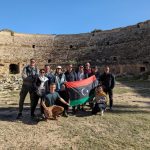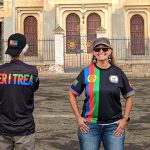The Corozal Commercial Free Zone, situated in northern Belize on the border with Mexico, was established in the 1990s to promote foreign investment in Belize. In theory there’s provision for many types of economic activities to happen there. The idea is that the zone sits outside of Belize Customs, so that goods and materials can be imported tax-free, processed and then sold or re-exported in a low-tax duty free environment, hopefully generating employment for locals in the process.
On a recent trip around central America, YPT’s Gareth and Alistair stopped off there while heading to Mexico after checking out some Belize real estate.
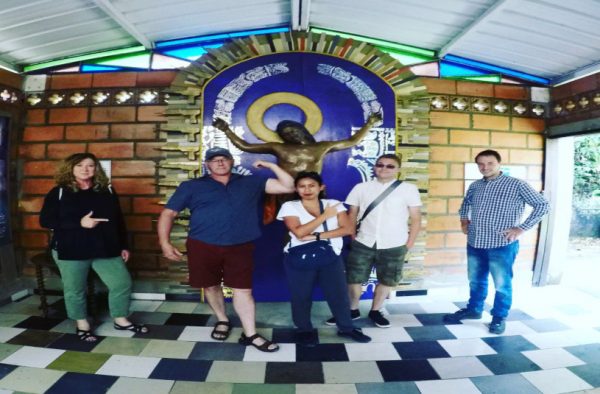
Our visit started off like most other land border crossings. We arrived by bus at the customs and immigration checkpoint on the Belize side of the border. Having handed over a small bundle of banknotes to pay the exit tax for the privilege of leaving Belize, our passports were duly stamped and walking out the other side of the building we had now left Belize. Except we hadn’t – we were now in the no-man’s land that lies between any two international land border checkpoints, and in this case, that’s quite a large area, which includes the Free Zone – outside of Belize customs and immigration control, but still in Belize national territory.
We hauled our bags the 10-minute walk to the Las Vegas hotel and casino, hoping to check in there and drop our bags before heading off to explore the Free Zone. Unfortunately, the hotel was way out of our price range so we set off again for the entrance to the Free Zone, another 5-minute walk. There’s another checkpoint at the entrance to the zone but they just waved us through. Now we were inside the zone, Gareth headed straight for the first shop selling soft drinks and cigarettes. The first problem we encountered was that almost everything is priced in Mexican Pesos – and we didn’t have any. A bit of discussion and calculation established that you can also pay in Belize currency, or US dollars, at the cost of a small commission to the seller.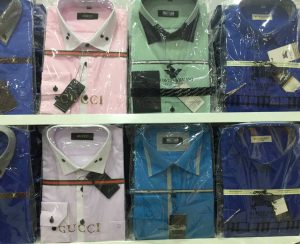
Unfortunately, there isn’t any Corozal Free Zone map or guide available, so we headed off on foot to see what we could find. Our next stop was a shop run by an Indian guy selling fake football strips. Gareth subscribes to the agnostic tradition of hedging one’s bets by supporting several teams, to increase one’s chances of picking the winner, so he bought five different tops from five different football teams, each for $5 US.
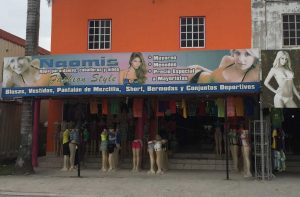
We found ourselves in a long street lined with shops selling all manner of cheap clothing, swimwear, shoes, handbags and suitcases. Instinctively we couldn’t help but feel that in amongst so much cheap stuff for sale, there really must be an unmissable deal that we couldn’t miss out on, so we pressed onwards, past numerous mannequins showcasing tight fluorescent leggings, skimpy bikinis and lacy underwear.
One shop unit we arrived at had recently burned to the ground. The charred remains of clothes racks and lacy underwear could be seen among the rubble. It didn’t look like there had been many efforts made to save anything. We wondered if it was an insurance job….
We figured we must have been in the ‘cheap clothing’ part of the zone, so hoped that we could find some more interesting goodies elsewhere, such as cheap iPhones and laptops. We headed back past the entrance and towards the other side of the zone, only to find entire streets of closed-down shops. We stopped at a roadside food stand to enjoy some tacos and consider our plan. We hoped to track down some WiFi to get online but there was none to be had anywhere.
We came across a booze shop with a collection of high-end spirits at pretty reasonable prices. Unfortunately, since we were still carrying everything by hand we didn’t fancy loading up with heavy bottles.
We did find a shop selling electronics – but the only iPhone was a fake one costing $180. At least they were good enough to be honest about it being fake. Apart from that, they had boxes of the sort of phone chargers which public information campaigns warn you against using in case they burn your house down. The most exciting thing was the dozens of colourful flashing LED signs relevant to all manner of small businesses.
Heading towards the exit on the Mexican side, we came across an entire street of boarded-up shops. Business in the zone had definitely taken a downturn. We passed a couple of derelict petrol stations. In the distance, we could see what looked like closed-down distribution warehouses or small factories. There was no sign of manufacturing or even wholesale of goods happening.
We walked out the exit and caught a cab to the Mexican immigration and customs checkpoint, where Gareth got a good shakedown for having an extra packet of cigarettes over the permitted duty-free limit.
In practice, the zone seems to have become a giant, rather down-at-heel duty-free area, with no sign. You won’t find any Hermes handbags or Cartier watches – at least not real ones.
But if you want to fill suitcases with cheap clothes while heading from Belize to Mexico (or vice versa) then it’s worth a visit.




